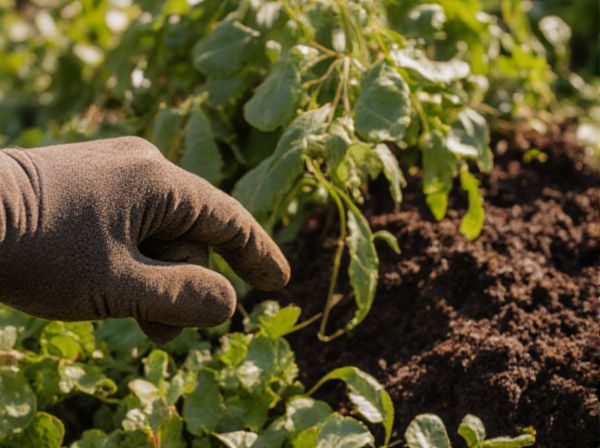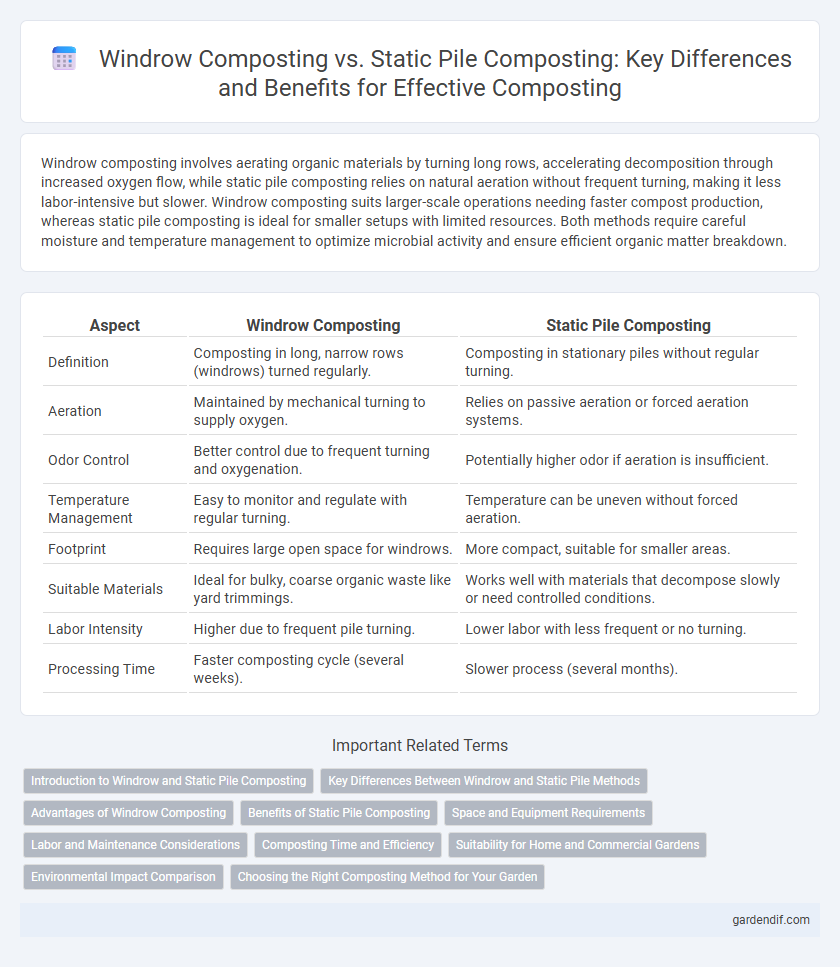
Windrow Composting vs Static Pile Composting Illustration
Windrow composting involves aerating organic materials by turning long rows, accelerating decomposition through increased oxygen flow, while static pile composting relies on natural aeration without frequent turning, making it less labor-intensive but slower. Windrow composting suits larger-scale operations needing faster compost production, whereas static pile composting is ideal for smaller setups with limited resources. Both methods require careful moisture and temperature management to optimize microbial activity and ensure efficient organic matter breakdown.
Table of Comparison
| Aspect | Windrow Composting | Static Pile Composting |
|---|---|---|
| Definition | Composting in long, narrow rows (windrows) turned regularly. | Composting in stationary piles without regular turning. |
| Aeration | Maintained by mechanical turning to supply oxygen. | Relies on passive aeration or forced aeration systems. |
| Odor Control | Better control due to frequent turning and oxygenation. | Potentially higher odor if aeration is insufficient. |
| Temperature Management | Easy to monitor and regulate with regular turning. | Temperature can be uneven without forced aeration. |
| Footprint | Requires large open space for windrows. | More compact, suitable for smaller areas. |
| Suitable Materials | Ideal for bulky, coarse organic waste like yard trimmings. | Works well with materials that decompose slowly or need controlled conditions. |
| Labor Intensity | Higher due to frequent pile turning. | Lower labor with less frequent or no turning. |
| Processing Time | Faster composting cycle (several weeks). | Slower process (several months). |
Introduction to Windrow and Static Pile Composting
Windrow composting involves forming organic waste into long rows that are regularly turned to supply oxygen, enhancing microbial activity and accelerating decomposition. Static pile composting creates stationary heaps that rely on aeration pipes or passive air flow to maintain aerobic conditions without frequent turning. Both methods optimize temperature and moisture control to effectively break down organic materials into nutrient-rich compost.
Key Differences Between Windrow and Static Pile Methods
Windrow composting involves aerating organic material by regularly turning long, narrow piles, promoting faster decomposition through enhanced oxygen flow. Static pile composting relies on passive aeration, where the material remains stationary and decomposition occurs more slowly due to limited oxygen supply. Temperature control, pile size, labor intensity, and optimal material types vary significantly between these two methods, influencing their efficiency and application suitability.
Advantages of Windrow Composting
Windrow composting offers superior aeration through regular turning, which accelerates the decomposition process and reduces odor emissions compared to static pile composting. This method enables better temperature control, ensuring effective pathogen destruction and enhanced microbial activity. Large volumes of organic material can be managed efficiently, making windrow composting ideal for commercial-scale operations.
Benefits of Static Pile Composting
Static pile composting offers significant benefits such as reduced labor requirements since the compost piles remain stationary, eliminating the need for frequent turning. It enables the decomposition of large volumes of organic waste in a smaller footprint, making it suitable for sites with limited space. Enhanced moisture retention and temperature stability in static piles create an ideal environment for efficient aerobic microbial activity, resulting in high-quality compost.
Space and Equipment Requirements
Windrow composting requires significantly more space due to the need for long, narrow piles that must be regularly turned with specialized equipment like windrow turners. Static pile composting occupies less area as piles remain stationary, relying on passive aeration or forced aeration systems, which reduces machinery needs. Windrow systems demand higher capital investment in equipment, while static pile methods are more cost-effective but may require aeration infrastructure for optimal results.
Labor and Maintenance Considerations
Windrow composting requires frequent turning with specialized machinery to maintain aerobic conditions, resulting in higher labor and maintenance demands compared to static pile composting. Static pile composting relies on passive aeration or forced aeration systems, reducing the need for regular turning and labor input, but may require monitoring and maintenance of aeration equipment. Efficient management of windrow systems involves consistent labor efforts, while static piles offer lower maintenance but depend on careful control of moisture and airflow to prevent anaerobic conditions.
Composting Time and Efficiency
Windrow composting typically requires 4 to 6 weeks for organic material to break down due to regular turning, which enhances aeration and microbial activity, leading to faster decomposition and higher efficiency. Static pile composting takes longer, often 8 to 12 weeks or more, as it relies on passive aeration and natural microbial processes, resulting in slower composting time and lower operational efficiency. Temperature control in windrow systems is easier, promoting consistent pathogen reduction and nutrient stabilization compared to the uneven conditions in static piles.
Suitability for Home and Commercial Gardens
Windrow composting is ideal for commercial gardens due to its ability to handle large volumes of organic waste and promote aerobic decomposition through regular turning, which accelerates the composting process. Static pile composting suits small-scale or home gardens by requiring less space and equipment while relying on passive aeration, making it easier to manage for gardeners with limited resources. Both methods effectively produce nutrient-rich compost but differ in scalability and operational complexity, impacting their suitability for varying garden sizes.
Environmental Impact Comparison
Windrow composting promotes aerobic decomposition through regular turning, reducing methane emissions and accelerating organic matter breakdown, which minimizes greenhouse gas impact. Static pile composting can produce more methane due to limited oxygen flow, leading to higher potential greenhouse gas emissions if not managed properly. Efficient oxygen management in windrow systems enhances microbial activity, resulting in lower environmental footprints compared to static piles.
Choosing the Right Composting Method for Your Garden
Windrow composting is ideal for large-scale organic waste management, using long, turned rows to accelerate decomposition through aeration, making it suitable for extensive gardens or farms. Static pile composting requires less space and minimal turning, relying on passive aeration, which fits well with small to medium-sized gardens or limited maintenance. Selecting between these methods depends on garden size, available labor, and desired composting speed, ensuring optimal nutrient-rich compost for soil health.
Windrow Composting vs Static Pile Composting Infographic

 gardendif.com
gardendif.com